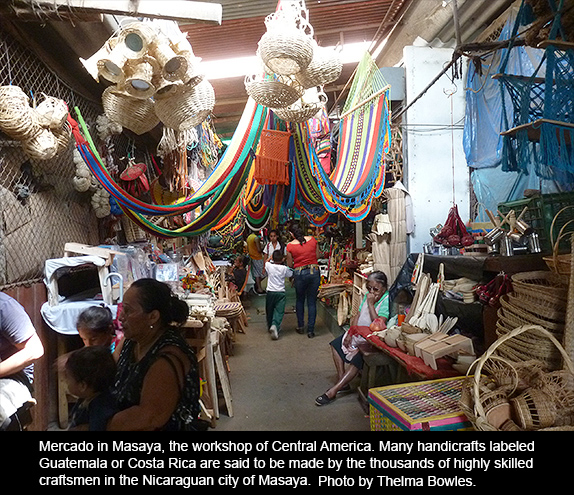
This is the fourth and last in a series of columns on a journey through Nicaragua
A quarter century ago, my wife and I were winding up our travel through a clutch of West African countries with a visit to Cameroon, my favorite of the dozen African countries I’ve seen. At that time (much has changed since, but alas, the president remains the same) it was lush and green, relatively prosperous and sophisticated, at peace with the world and itself. Feeling good about our successful journey in a difficult part of the world, my wife and I relaxed, wanting only to melt into the local scene and recover our energy for the trip back to our base in Niger.
When a local youth saw us laden with packs and helpfully offered to show us a shortcut, we hesitated, but agreed to follow him. As dark was setting in, we crossed a deserted lot where several of his friends waited in ambush, assaulted us and stole all our possessions, including our money and passports.
Such a crime couldn’t happen here, not here in this peaceful place, local and U. S. officials marveled when we reported the theft. But it was precisely because this was a peaceful place that we had let out guard down and gone where we never would have in one of the patently dangerous cities of, say, Nigeria.
I was reminded of this long-forgotten incident earlier this month when a question on a U.S. passport form asked if I had ever before had my passport stolen. The question occurred because of another bit of idiocy.
Earlier this month, my wife and I had been delighted with our first two weeks of negotiating Nicaragua by bus, eating street food, drinking tap water, Victoria Classica beer and terrific Flor de Caña rum while remaining healthy and strong, improving our Spanish and generally blending into the local culture as is our wont.
After seeing a lot of this deeply impoverished but entrancing country, we were at one of our last stops, the small, un-touristy and unheralded city of Matagalpa, which to our surprise, was the most pleasing city in the entire country. High and cool and green, it is closely surrounded by dramatic mountains. Its streets are lined with small cafés and restaurants. Its old churches and attractive parks are magnets beckoning passersby to pause and rest and relish the peace and beauty. The commercial center of the coffee-growing region, it wears prosperity with a tinge of pride.
So we relaxed, so much so that when we got out of a taxi, I left our daypack on the floor of the back seat—out of sight and thus unfortunately out of mind. When I ran back to retrieve it, the taxi had driven off, never to return. The pack contained a few hundred dollars in U.S. and Nicaraguan currency, a credit card, a debit card, my driver’s license and our passports.
With a good bit of trouble, the somewhat grudging help of the US. embassy and the friendly cooperation of a number of Nicaraguans, we were able to get everything straightened out over a few days. The only real casualty was we lost our chance to visit the Corn Islands, two enticing bits of land 70 miles offshore in the Caribbean Sea.
As with Cameroon a quarter century earlier, it was because I felt good and was in a good place that I relaxed my usual vigilance and became dumb and careless.
This minor, but thoroughly unpleasant episode taught me once again the lesson of veteran travelers: No matter how successful your past experiences, live in the moment; no matter how good a place feels, take care—and most of all, no matter how smart and tough you feel, remember that in a foreign country, you are always vulnerable.
We are not the only ones to become too relaxed in this easygoing country. The Spaniards thought so highly of it that in the early 16th century they built their glorious regional capital, Grenada, on Lago Nicaragua with direct access to the Caribbean Sea via the Rio San Juan, only to see pirates take advantage of the ready access to raze it repeatedly. The rival capital of Léon was in a moment of carelessness built at the foot of a volcano, which destroyed it. Nicaragua has more than 40 volcanoes, half of which remain active. Every couple of years, one or another of them blows up. We walked around the crater of Volcán Masaya, one of the country’s most active volcanoes, only half an hour’s drive from downtown Managua, now a city of more than 1 million that, in its turn, had been destroyed by an earthquake in 1972. Throughout our three weeks in Nicaragua, we were almost always within sight of a volcano, often one with steam emitting from its crater, which never seemed to stop relaxed Nicaraguans from farming at their base and even more relaxed tourists from hiking the craters. On Isla Ometepe we slept in a tent pitched between two volcanoes. What, we worry?
Several of the volcanoes have large lakes in their craters. Possibly the most beautiful is Lago Apoyo, near Grenada. It is very deep and very clear, surrounded by deep green forests and bordered by sandy beaches, a wonderful place to swim or kayak or just escape the humid heat of Grenada.
Nicaragua, in fact, has lakes everywhere you look. Lake Nicaragua, which borders Grenada, is the largest lake in Central America and the second-largest lake in all of Latin America. Lake Managua, on the edge of the capital, is Central America’s second-largest lake.
There are lakes in the volcanoes and volcanoes in the lakes. Add in a large artificial lake, a number of rivers up to 300 miles long, and more than 500 miles of coastline on the Atlantic and Pacific, as well as a vast swath of country in the east that is so water logged the only transportation is by boat, and you have a nation that seems to be as much water as land.
All this water produces some wonderful beaches. Playa Coco in the south near the Costa Rica border, is one of those picture-perfect places with deserted broad white sand and calm turquoise ocean. Notwithstanding the numerous tourist brochures featuring pictures of this photogenic beach, it seems a long ways from anywhere, with only a handful of houses and on a road that grinds to a dead end before it reaches Costa Rica to the south. The unique geography of Nicaragua is the source of endless beauty, but it is equally the source of centuries of tragedy and, today, an inexhaustible encyclopedia of problems. While the country no longer has to contend with pirates, U.S. Marines, a civil war between León and Grenada, vicious dictatorships and guerrilla warfare, it has a panoply of other problems including poverty, drought, global warming, earthquakes, volcanic eruptions and an autocratic political system.
The economy is growing at the moment, slowly but steadily. So far the limited tourism is helping supply jobs without destroying the culture. Alternative energy is blossoming. New high-margin crops like tobacco and flowers are helping small farms survive. Expats from Germany, Canada and the United States are bringing resources and skills to both cities and the countryside.
Nicaraguans approach their hard lives and their relations with North Americans with a modest self-confidence that is unusual in Latin America, lacking both machismo and shame, perhaps because they are the only Latin Americans to have defeated the U.S. twice. They honor their own poets as national heroes, and every February, the poets of 60 countries fill the central plaza and narrow downtown streets of Grenada with Latin America’s only international poetry festival. In Masaya, thousands of artisans produce Central America’s best textiles, leather goods, pottery and other handicrafts. In the old university city of León nearly every wall is covered with vivid murals.
So this is a nation that is not without hope. The sense of optimism here is palpable, but ever so fragile, held hostage to the next earthquake, the next revolution. But maybe, just maybe, Nicaragua may make it. I hope so, for the mere continued existence of such a place enriches all our lives.



Responses to “Nicaragua, Part 4: Safe places are the most dangerous”